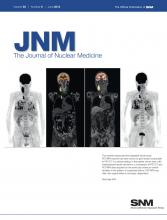Abstract
The recently introduced first integrated whole-body PET/MR scanner allows simultaneous acquisition of PET and MRI data in humans and, thus, may offer new opportunities, particularly regarding diagnostics in oncology. This scanner features major technologic differences from conventional PET/CT devices, including the replacement of photomultipliers with avalanche photodiodes and the need for MRI-based attenuation correction. The aim of this study was to evaluate the comparability of clinical performance between conventional PET/CT and PET/MR in patients with oncologic diseases. Methods: Thirty-two patients with different oncologic diagnoses underwent a single-injection, dual-imaging protocol consisting of a PET/CT and subsequent PET/MR scan. PET/CT scans were performed according to standard clinical protocols (86 ± 8 min after injection of 401 ± 42 MBq of 18F-FDG, 2 min/bed position). Subsequently (140 ± 24 min after injection), PET/MR was performed (4 min/bed position). PET images of both modalities were reconstructed iteratively. Attenuation and scatter correction as well as regional allocation of PET findings were performed using low-dose CT data for PET/CT and Dixon MRI sequences for PET/MR. PET/MR and PET/CT were compared visually by 2 teams of observers by rating the number and location of lesions suspicious for malignancy, as well as image quality and alignment. For quantitative comparison, standardized uptake values (SUVs) of the detected lesions and of different tissue types were assessed. Results: Simultaneous PET/MR acquisition was feasible with high quality in short acquisition time (≤20 min). No significant difference was found between the numbers of suspicious lesions (n = 80) or lesion-positive patients (n = 20) detected with PET/MR or PET/CT. Anatomic allocation of PET/MR findings by means of the Dixon MRI sequence was comparable to allocation of PET/CT findings by means of low-dose CT. Quantitative evaluation revealed a high correlation between mean SUVs measured with PET/MR and PET/CT in lesions (ρ = 0.93) and background tissue (ρ = 0.92). Conclusion: This study demonstrates, for what is to our knowledge the first time, that integrated whole-body PET/MR is feasible in a clinical setting with high quality and in a short examination time. The reliability of PET/MR was comparable to that of PET/CT in allowing the detection of hypermetabolic lesions suspicious for malignancy in patients with oncologic diagnoses. Despite different attenuation correction approaches, tracer uptake in lesions and background correlated well between PET/MR and PET/CT. The Dixon MRI sequences acquired for attenuation correction were found useful for anatomic allocation of PET findings obtained by PET/MR in the entire body. These encouraging results may form the foundation for future studies aiming to define the added value of PET/MR over PET/CT.
Footnotes
Published online Apr. 25, 2012.
↵* Contributed equally to this work.
- © 2012 by the Society of Nuclear Medicine, Inc.







